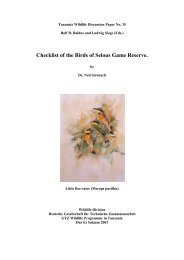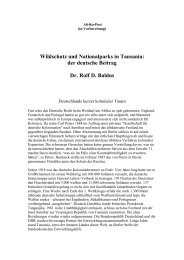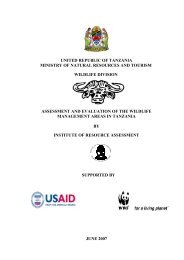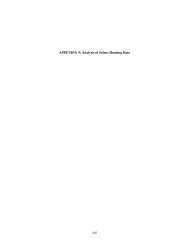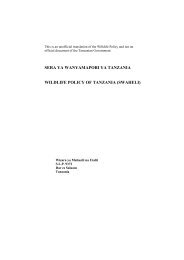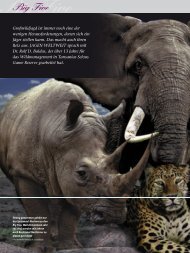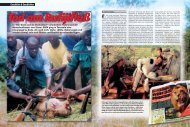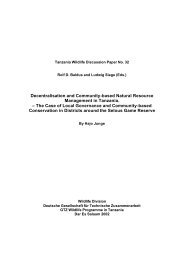African Indaba Articles - wildlife-baldus.com
African Indaba Articles - wildlife-baldus.com
African Indaba Articles - wildlife-baldus.com
You also want an ePaper? Increase the reach of your titles
YUMPU automatically turns print PDFs into web optimized ePapers that Google loves.
quality and age of key species being hunted has declined. Legal hunting for meat by <strong>com</strong>munities may nothave reached unsustainable levels. The unsustainable levels of hunting key species is in part due to the lackof an objective system for quota setting for hunting, and many hunting quotas are issued that allowunsustainable levels of hunting. Hunting also takes place ‘above’ quotas. The general lack of respect for thelaw by the members of the private sector (e.g. hunting above quotas) has prompted the Director of Wildlife toissue a Call for Compliance to all hunters in 2004. However, no serious effort to prosecute violations hasbeen observed.RevenueWith no objective or transparent system for the allocation of hunting concessions to the private sector,concessions are leased at administered prices far below the true market value irrespective of size, quality orin<strong>com</strong>e potential. This is done by a few key government officials, who maintain a high level of control with theawarding of concessions. This represents a large loss of in<strong>com</strong>e to Tanzania, and more specifically the WD(estimated at more than US$7 million). For instance, the number of hunting clients in Tanzania has gone upwhile the in<strong>com</strong>e to WD has remained the same. Moreover, many concessions (up to 70% of allconcessions) are leased to hunting operators without the capacity to market or manage their own huntingoperations. The system thus promotes subleasing to foreigners with a result that much of the in<strong>com</strong>egenerated by the industry never benefits the country.4. AnalysisThe current management of the Wildlife Sector and specifically the hunting sector is an example ofshort<strong>com</strong>ings in governance, but serves well the short-term interests of some of the present huntingconcession holders and a few government officials. There is therefore a strong resistance to reform. Thepresent system endangers the long-term sustainability of the use of <strong>wildlife</strong>. It provides neither theGovernment nor the <strong>com</strong>munities what is due to them according to Tanzanian law. Instead it serves theinterests of a minority in the private sector and the government. It is a misallocation of resources resultingfrom a non-market system which is administered at the discretion of a few individuals. The opening up of theTanzanian economy to a market-based system has not yet found its way into the Wildlife Sector.5. Action Already TakenA number of initiatives have been taken by Government and development partners within the field ofmonitoring, quota setting, improved revenue generation and retention. None of these schemes has so farbeen successful at providing a <strong>com</strong>prehensive solution to the fundamental problems. Examples are:• At the request of the MNRT the financial administration of the Tourist Hunting Section was<strong>com</strong>puterised in the mid-nineties with financial assistance from a donor. This system would havegreatly increased transparency and reduced potential for fraud. It was finalised in 1998, butnever applied.• A report on the Tourist Hunting Industry has recently been produced (2004). This study is thefirst and only presentation of empirical economic data for Tourist Hunting in Tanzania. This studyis confidential, copies have been presented to the Wildlife Division, but there has been noresponse.• A database has been developed for tourist hunting in the Selous Game Reserve from 1988 topresent. A monitoring of hunting trophy quality has been introduced in the Selous Game Reservesince 1998 with results recorded into this database. The database (without trophy monitoring)has been expanded for game reserves in north-western Tanzania.• An unsuccessful Kenyan proposal in 2004 to raise the <strong>African</strong> lion to Appendix I of CITES hasprompted the Wildlife Division to introduce minimum requirements for legal hunting of liontrophies. Similar requirements are in place for elephant and leopard trophies, althoughundersized trophies continue to be exported, (minimum weight of a single elephant tusk is set,minimum body length of leopard and minimum age of lion trophies are established). However,the recent requirements for lion introduce an opportunity to promote certification in the industryand introduce its reform on the international stage, in a similar manner to certification in theForestry industry.• Retention schemes, whereby 50% of the in<strong>com</strong>e generated from hunting within remains with themanagement, have been established in Selous Game Reserve, Rukwa Game Reserve and the58



